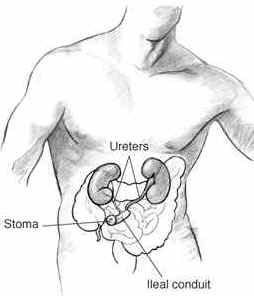|
|
||||||||||||||
|
Surgery for bladder cancer |
Home Treatments Lifestyle Symptoms Cancers | |||||||||||||
The type of surgery for bladder cancer depends on the stage, grade of the disease and condition of the patients. There are various techniques used for surgery for bladder cancer: LOCAL RESECTION In early stage of the disease, the tumour may be removed (resected) using instruments inserted through the urethra (transurethral resection). This is usually well tolerated involving a short general anaesthetic. Patients may go on to have intravesicle chemotherapy or immunotherapy followed by a plan for future cystoscopies at regular intervals. TOTAL REMOVAL (Radical cystectomy): This applies to bladder cancer that has spread deeper into the muscle wall (e.g., Stage T2 T3a), looks aggressive down a microscope (high grade) or has not responded to superficial treatments. The whole organ must be removed. In men, it is usual to remove the bladder and prostate (cystoprostatectomy) with some pelvic lymph nodes and often the seminal vesicles (semen-conducting tubes). In some cases, this can be performed in a manner that preserves sexual function. In women, it is usual to remove also the the uterus, ovaries, fallopian tubes, anterior vaginal wall, and urethra.
Complications include general problems relating to major surgery - infection, deep vein thrombosis, and later complications such as urinary stones, infection and blockages. Newer surgical methods may eliminate the need for an external urinary appliance. OTHER PROCEDURES Segmental cystectomy (partial removal of the bladder), which is a bladder-preserving procedure, may be used in some cases (e.g. patient with squamous carcinomas or adenocarcinomas that arise high in the bladder dome). Continent
urinary reservoir is a urinary diversion technique used for reconstruction
of the lower urinary tract. This involves using a piece of the colon (large
intestine) to form an internal pouch to store urine. The pouch is specially
reconstructed to prevent back-up of urine into ureters and kidneys. The patient
drains the pouch via a catheter several times a day, and the stoma site is
easily concealed by a band aid.
Further general information Your doctors and specialist nurses are in an ideal position to give you relevant information on your disease and treatment as they know your individual circumstances. Cancerbackup has a help line (0808 800 1234) and a prize winning video available in English, Italian, Urdu, Bengali, Gujarati & Hindi explaining Radiotherapy & Chemotherapy. Cancernet.co.uk has over 500 pages describing cancer, its management, practical tips and tool which patients, their carers and their doctors have found helpful during the cancer journey. |
||||||||||||||
 Patients require a urostomy (opening in the abdomen created for the discharge
of urine) usually in the form of an ileal conduit created from a small piece of
patient's bowel which acts as a channel to bring the urine from the ureters to
the surface of the abdomen. The urine is further taken out of the body
through a small opening in the abdomen which is called a stoma. An external,
urine collecting bag is then worn at all times.
Patients require a urostomy (opening in the abdomen created for the discharge
of urine) usually in the form of an ileal conduit created from a small piece of
patient's bowel which acts as a channel to bring the urine from the ureters to
the surface of the abdomen. The urine is further taken out of the body
through a small opening in the abdomen which is called a stoma. An external,
urine collecting bag is then worn at all times.




